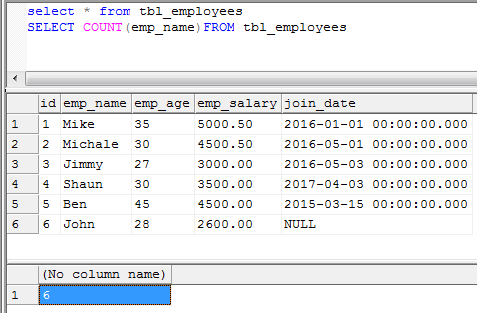
#Mysql join select statement how to#
In this article you have learned how to use the JOIN statement to join together three different tables.The article presents a detailed tutorial on MySQL JOINs. It has to be used in conjunction with the ON statement to determine the relationship between the rows of a table and the rows of a different table. The JOIN statement lets you join together one or more tables. The matches table is not shown in the output but it is used as instructions for how to combine the rows of the teams and projects tables. There is no column directly from the matches table.

Each row of the output table has the project name and the team name combined using the pairs of project id and team id in the matches table. The ON statements teams.id = matches.team_id and matches.projects_id = projects.id mean that the rows are combined using the rows of the matches table. We specify how the rows of the tables are to be combined with an ON statement.Īnd we order the rows in the way we prefer with an ORDER BY statement. We choose which columns to show from each table with a SELECT statement. We can use a JOIN statement to put everything together when we need to view the info from the tables in a human readable way, like this: SELECT Some more wood gnawing and ground stomping neededĪs a team can work on multiple projects, and a project can be worked on by multiple teams, there is also a third table that keeps track of team-project matches. Let's imagine we have an organization's database, where we have a table with teams (their name, and other identifing info), and a table with projects (name, progress, and so on). In practice in MySQL, that middle table will have a column for first_table_id and a column for second_table_id, with each combination being unique. This kind of relationship can't be represent as is with SQL tables – you need to add a coupling table between the two tables so that only many-to-one and one-to-many relationships are present between tables.Įach row of the table in the middle represents one relationship between the rows of the left table and and the rows of the right table. In this case multiple rows are related to multiple rows. In a relational database this can be implemented with the first table having a second_table_id column that says to which row of the second table that row is related. In a many-to-one kind of relationship, one row of the first table can be related to one single row of the second table, and one row of the second table can be related to multiple rows of the first table. In a relational database this can be implemented with the second table having a first_table_id column that says to which row of the first table that row is related. In a one-to-many kind of relationship, one row of the first table can be related to multiple rows of the second table. When you have tables that are related to each other, their relationships could be one of various types. Let's talk a moment about the relationships you can have between tables and why you might want to join three tables together.

To do that you add a second INNER JOIN statement and a second ON statement to indicate the third table and the second relationship. ON table2.id = table3.id Generic INNER JOIN statement between three tables It is possible to use multiple join statements together to join more than one table at the same time. In this case the two tables are joined using the relationship table1.id = table2.id.

How the two tables should be joined is written in the ON statement. FROM statement indicates which is the first table, then the second table name is written just after the INNER JOIN keywords.

ON table1.id = table2.id Generic INNER JOIN statement between two tables Join is a statement that lets you put together two tables, matching rows that are related to each other, and keeping only the rows that can be matched, not keeping unpaired rows. I have already written about SQL joins here and here, but let's take a moment to review how a join works first, and particularly the syntax specific to MySQL. When you're working with your database, you might need to put together data from a few different tables.


 0 kommentar(er)
0 kommentar(er)
